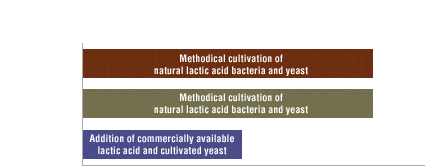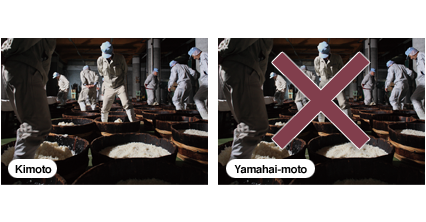
It is the authentic Kimoto method for brewing sake that produces the smooth, dry character of Kiku-Masamune's sake. This painstaking technique, which constitutes the very origin of sake-brewing, comprises an ancient method for creating moto (shubo), the yeast starter mash, that will ultimately produce the alcohol in the beverage from water, rice, and malted rice (koji). However, due to the fact that this approach, which takes four weeks from start to finish, consumes about twice as much time and effort as the normal method and requires a technique that is extremely difficult to accomplish in a stable, consistent manner, only a very few of more than 1,000 sake breweries in Japan employ it. Most breweries add commercially available lactic acid and cultivated yeast in what has become known as the "quick fermentation" method (sokujo-moto), which yields results in a little more than two weeks. Nonetheless, the Kimoto method, which has been passed down from the hands of one generation of master brewers to the next, has begun to attract renewed attention.


Yeast produced by the sokujo-moto method is prone to die at the end of the fermentation process, triggering the release of impurities that detract from the flavor of the sake. By contrast, most of the fungus in mash made using robust yeast that has survived the harsh biological competition of the Kimoto method does not die even in the face of alcohol concentrations as high as 20%, creating sake with beautiful character and few impurities. This sake has the superb flavor of authentic dryness, a hint of robust roughness, and a refreshing, crisp finish that lacks any unpleasant sweetness. We're proud of the distinctive, rich taste (oshi-aji) that results from the Kimoto method, a broad and deep flavor made possible by methodically drawing out the savory flavor of the sake.